Fireplace with a hob for the kitchen: design features and design ideas

For heating and decorating their own home, people are increasingly resorting to installing a fireplace - it is not only beautiful and stylish, but also functional. Currently, the choice of the presented fireplaces is quite wide: you can choose small or large-sized models, wood-burning or electric, real or decorative. However, now the demand is growing more and more for combined designs, such as a fireplace stove with a hob.

Specifications
A fireplace with a hob is a multifunctional device that is used to heat a room, prepare food and create a cozy atmosphere in the home. The properties described above make it possible to install this unit in country buildings where gas is not supplied, on the territory of a private house or a small apartment.
Heating and cooking ovens are stationary and portable. In the first case, the weight of the structure is on average 45 kg, and in the second - about 30 kg.
But in any case, this parameter directly depends on the material of manufacture and the availability of finishing.
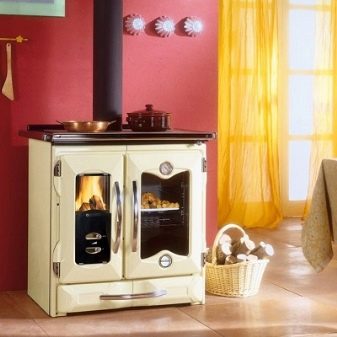

The main type of fuel for these structures is wood, but often peat, brown coal or pellets are used for heating. At the same time, there are furnaces operating on one type of fuel or using a combination of the above materials. As for the cooking process, there are options on sale both with a conventional hob and with collapsible burners that open access to an open fire.
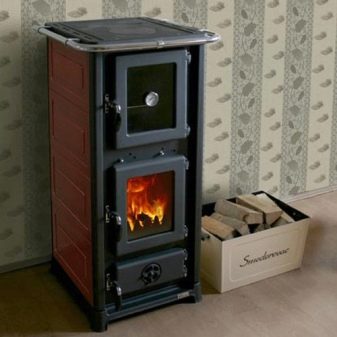
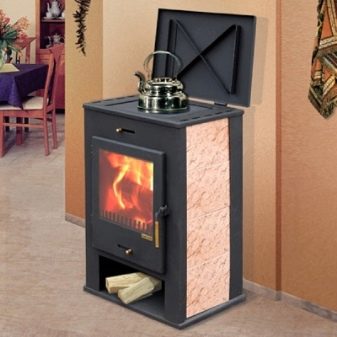
Unlike the standard version, the fireplace stove does not require a foundation: it can be placed on any surface.
Principle of operation
By their structure, fireplace stoves with a hob resemble a metal potbelly stove. However, the modern version has a more sophisticated appearance.
The design consists of 3 parts: in the middle of the device there is a section for filling fuel material and equipped with a heat-resistant glass door, above it there is a hob, and below it is an ash pan, where combustion products (ash) get. The lower compartment is usually completed with a drawer for easy cleaning.
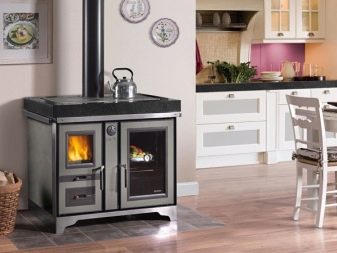

The control and regulation of the force of combustion of the flame is carried out by means of traction (opening and closing the blower). For the combustion process to take place safely, a strong thrust is required, for which the outlet pipes should be connected to a vertical pipe with a length of at least 5 m.
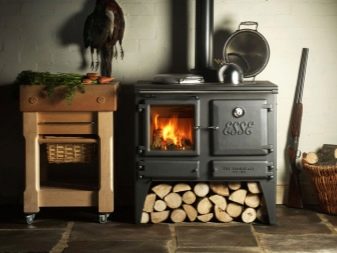
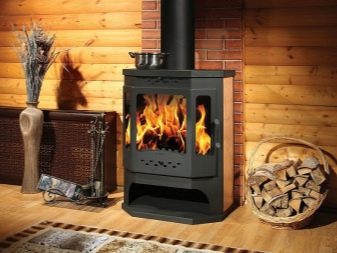
Advantages and disadvantages
A stove-fireplace with a hob is in demand among consumers due to a number of positive properties.
- Compactness. The small dimensions of the device make it possible to install it in rooms with limited area: in country houses, studio apartments.
- Profitability. Since this option combines the properties of a fireplace and a stove, this allows you to significantly save money on heating the room and maintaining the hob.
Mostly firewood is used as fuel, which is the most budgetary option of all.
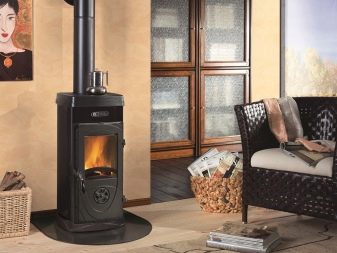
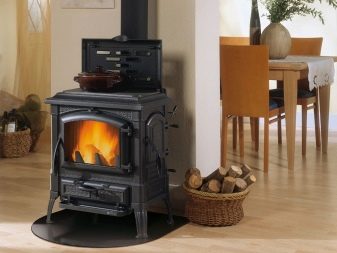
- Versatility. Due to the variety of the presented assortment, fireplaces will harmoniously fit into interiors of various styles: classic, modern, hi-tech, minimalism.
- Aesthetics. The sound of firewood crackling in the firebox, a living flame, and outgoing heat - all this creates a cozy and comfortable atmosphere in the room.
- Efficiency. The fireplace stove is capable of heating large rooms. In addition, unlike other appliances of a similar effect, fireplaces with a stove maintain optimal heat for a long time.
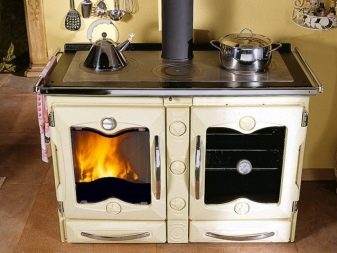
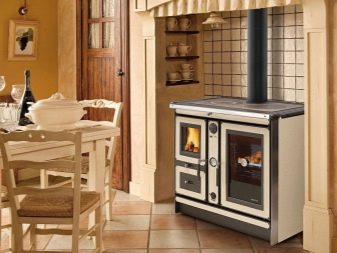
- Fire safety. Such structures do not pose any danger to the environment. Even with prolonged burning, there is no likelihood of fire on walls, floors, furniture, adjoining countertops.
- Environmental friendliness. The materials used in the production process are safe: they do not emit harmful and toxic substances under the influence of fire.

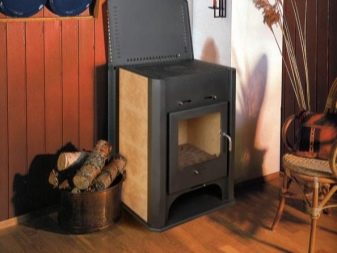
In addition to all of the above, fireplaces with a hob function regardless of the availability of electricity, thereby acting as the main source of heating and cooking.
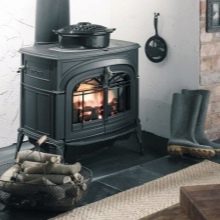

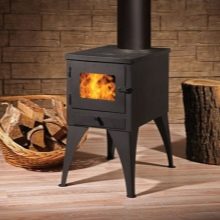
Negative sides:
- unequal distribution of heat: first of all, the upper part of the room warms up, while the lower part remains cold for a long time;
- the fireplace cannot be left idle for a long time, otherwise dust will form in the firebox, which will begin to burn during the next combustion, thereby creating an unpleasant smell in the room;
- the most successful and stylish options are very expensive.
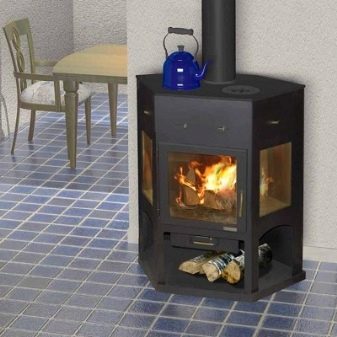
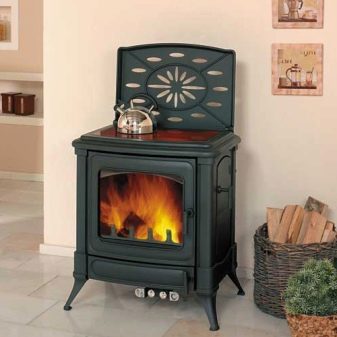
Selection Tips
Primarily, you should pay attention to such design parameters as heat output and the volume of the room for heating. Standard installations are capable of heating houses with an area of 80-100 sq. m (in the event that they are located in the middle of the room or in an open access area). There are options that can provide heat up to 250 sq. m of a country house: these are cooking ovens equipped with a water circuit.
You also need to pay attention to the type of fuel used.
Most of the models presented work on wood, but there are pyrolysis and universal solid heating stoves, they are more expensive than conventional options.

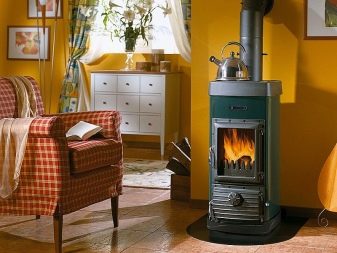
Equipment and functionality are also important parameters. It is certainly better if the fireplace has a lot of possibilities. This improves the quality of heating and cooking and simplifies the maintenance of the structure.
It is advisable to buy products from trusted suppliers who have won recognition for their high quality, reliability and durability. These include Tulikivi, Eurokom, MBS Magnum, Greivari, Termofor, Ekokamin.



When choosing a fireplace, you need to pay attention to its appearance. This is a visible piece of furniture, so it should be beautiful and suitable for the overall style and layout of the room.
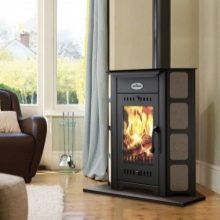
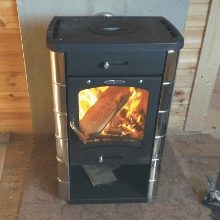
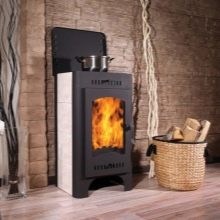
Manufacturing materials
Fireplace installations with a hob for the kitchen are made of different materials: steel, cast iron, brick.
Metal models are distinguished by effective heat transfer, quick warm-up, but also the same fast cooling. In addition, their small dimensions allow, if necessary, to change their location (for example, transfer from the kitchen or living room to the summer veranda), however, such a rearrangement is extremely rare, since together with it you will have to reinstall the chimney and equip the fire-safe area.


Steel and cast iron structures are capable of heating rooms up to 100 sq. m, and in the presence of a water circuit - even more. Metal appliances are of the vertical type and horizontal. The stove in this case acts rather as an auxiliary equipment. Due to the fact that it is located very close to the main heating zone, it provides quick cooking and instant heating.
Comparing cast iron and steel structures with each other, it is worth noting that cast iron furnaces are more reliable and durable, and steel options are more practical, lighter in weight and cheaper.
However, they are all inferior to brick products.
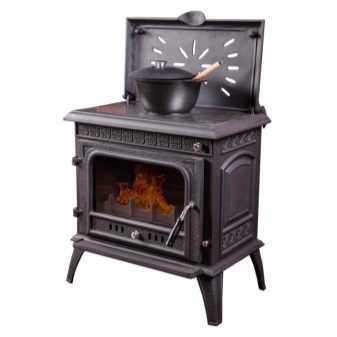
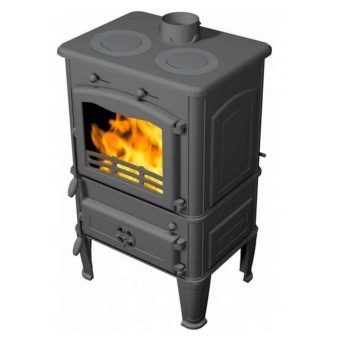
Brick fireplaces, combined with a hob, are mainly erected in private houses according to ready-made projects. This is a very time-consuming process that requires the laying of a separate foundation that is not associated with the foundation of the building. Brick structures, in addition to the stove, may include an oven, steam outlet, etc.
The main part of the structure is built from refractory bricks, and the firebox is often replaced with a special heat-resistant blank. A brick oven works similarly to a cast iron unit according to the convection-beam principle, however, unlike it, it accumulates and gives off more heat.

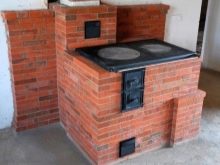

Popular models
It is difficult to come up with new designs of such a complex heating and cooking device that would be safe, functional and beautiful at the same time.
It is worth paying attention to the exquisite models presented by well-known manufacturers.
- At a well-known domestic company among consumers "Eco-fireplace" there are many interesting models, but Bayern is considered the most popular. In appearance, the structure resembles a standard gas or electric stove, so it will harmoniously fit into the interior of any kitchen and will not knock out of it. A transparent glass door protects the combustion space from the outside, and a kitchen screen protects the hob. The device has optimal dimensions, allowing it to be used comfortably: you do not have to stand on your toes to reach the burner or bend low to add firewood.
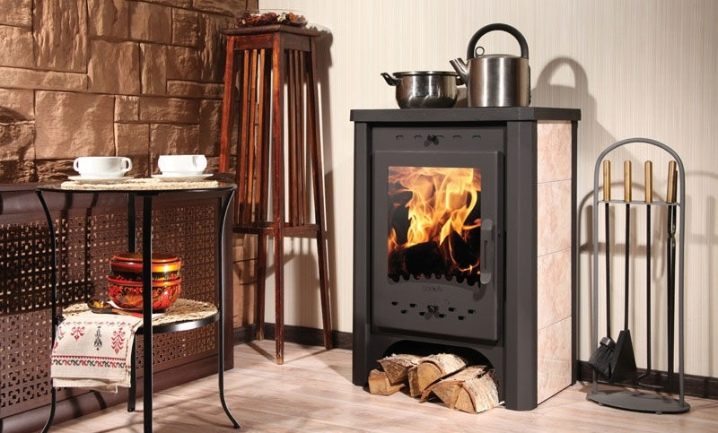
- Stove-fireplace Ambra from the Polish company Eurokom is made in retro style. It differs from other models in aristocracy and elegance: artificially aged cast iron, graceful legs, various openwork ornaments and patterns both on protective covers and doors, and on the case itself.
This sophisticated model can be positioned in a classic-style interior. It will be appropriate to complement the patinated forged products in the decoration of the room: door handles, chandelier elements, candlesticks, stands.
In the Provence style, this design will also look interesting. However, one must not forget to adhere to the basic canons of style: simplicity of decoration, natural materials, wooden furniture, an abundance of textiles. A fireplace with a hob Ambra will also successfully complement kitchens and dining rooms made in the Empire and Baroque styles, but it will look out of place in modern and oriental design directions: loft, hi-tech, minimalism, modern, bio-tech, functionalism.
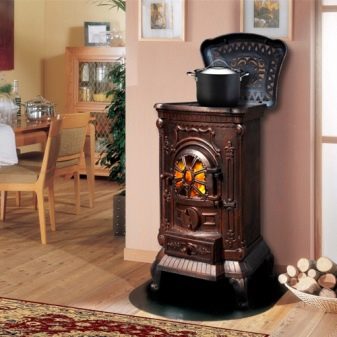

- An interesting and modern version of a heating and cooking fireplace is model "Angara 12" from the Belarusian company "Meta". The model is made of steel, coated on the outside with heat-resistant enamel. The side walls are finished with ceramic tiles, which not only makes the fireplace more attractive, but also increases its heat transfer. In addition, the structure is equipped with a correct chimney hood, two burners and a three-sided panoramic heat-resistant glass that limits the area of the firebox.
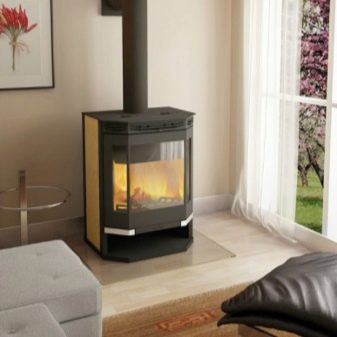
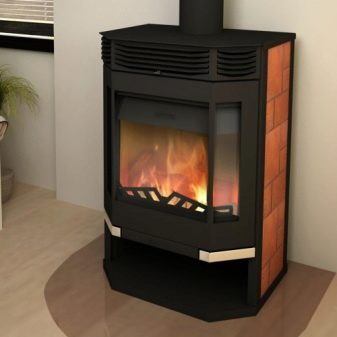
The "Angara" stove assumes several options for wall-to-wall arrangement in the interior, including an angular one, which allows you to leave a maximum of free space in the room.
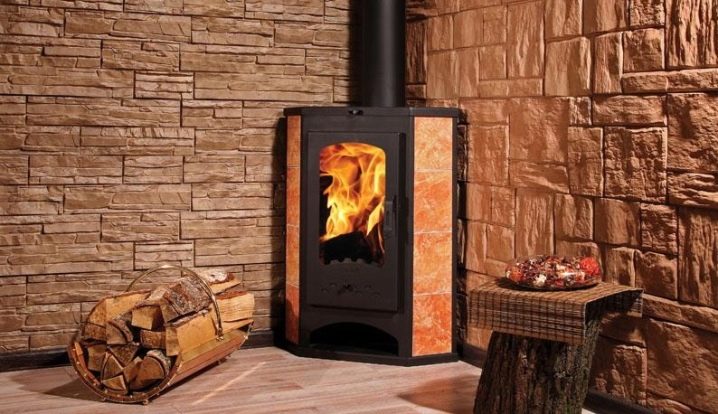
Safe use instructions
- It is necessary to position the fireplace on a base made of heat-resistant material. For purchased models, in most cases, ceramic tiles act as such. If it was decided to erect the structure with your own hands, then a concrete pad should first be poured onto the base, leaving a small gap in front of the firebox, on which the galvanized sheet is subsequently laid.
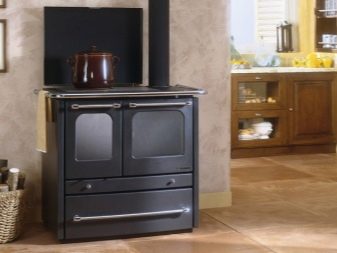
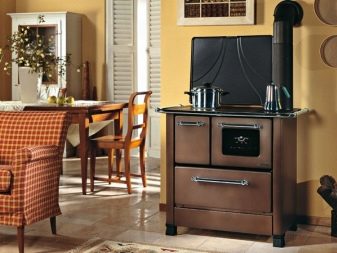
- In order for the combustion process to be carried out efficiently and safely, the fireplace requires constant access to outside air. To do this, after each firebox, thoroughly clean the chimney and ash pan, and also control the timely supply of oxygen.

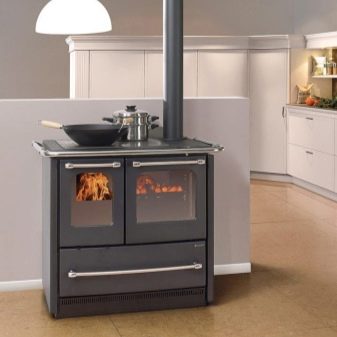
- Try not to close the plugs even in winter, when the heat from the fireplace insert is lost to a great extent. Otherwise, carbon monoxide will begin to flow into the room, which is dangerous not only for health, but also for life in general.
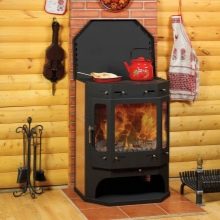

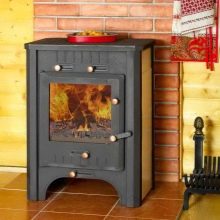
You can watch an overview of one of these heating and cooking stoves with a fireplace in the video below.













The comment was sent successfully.